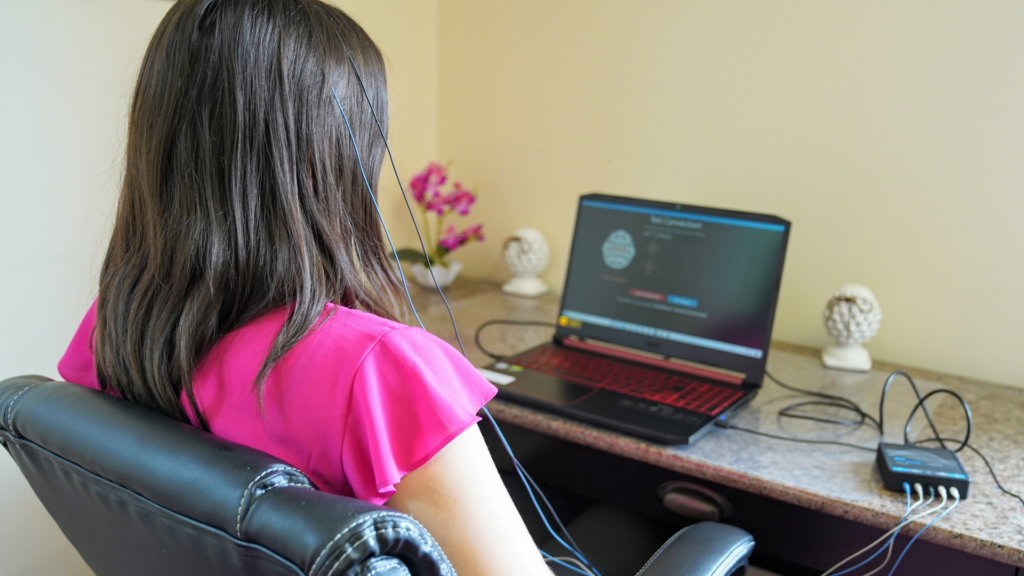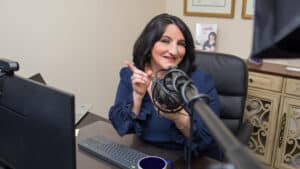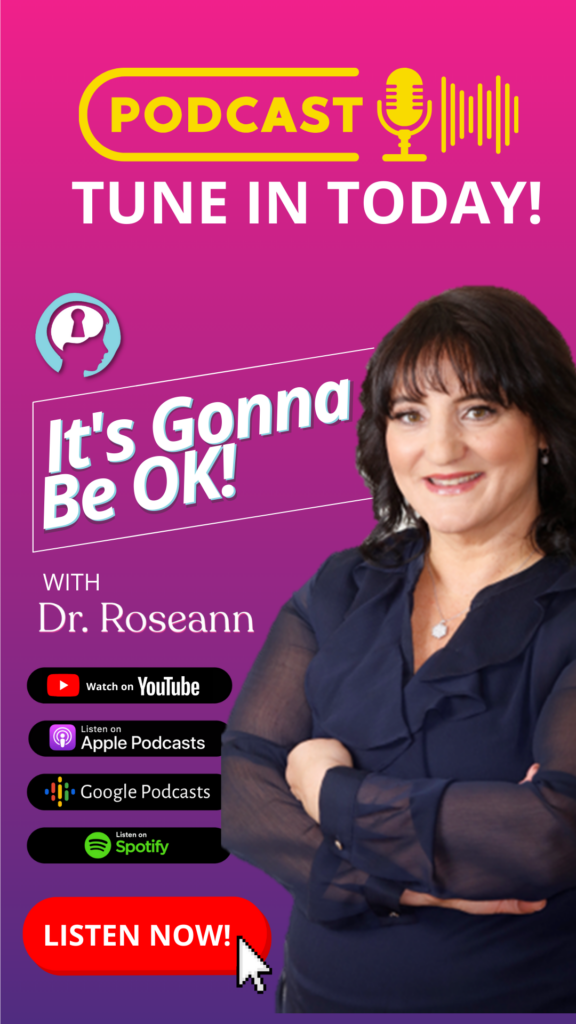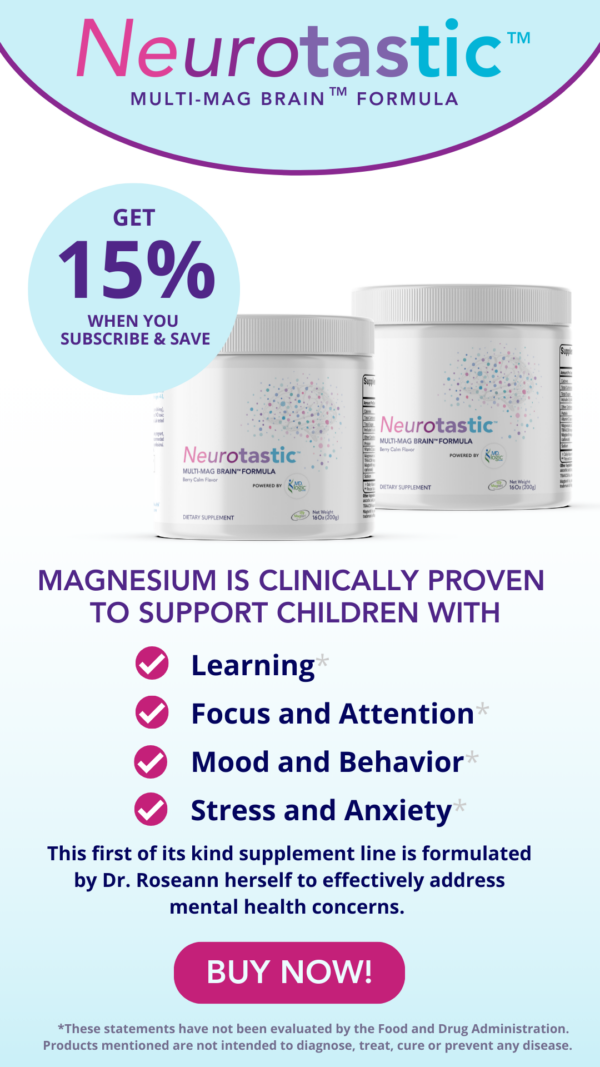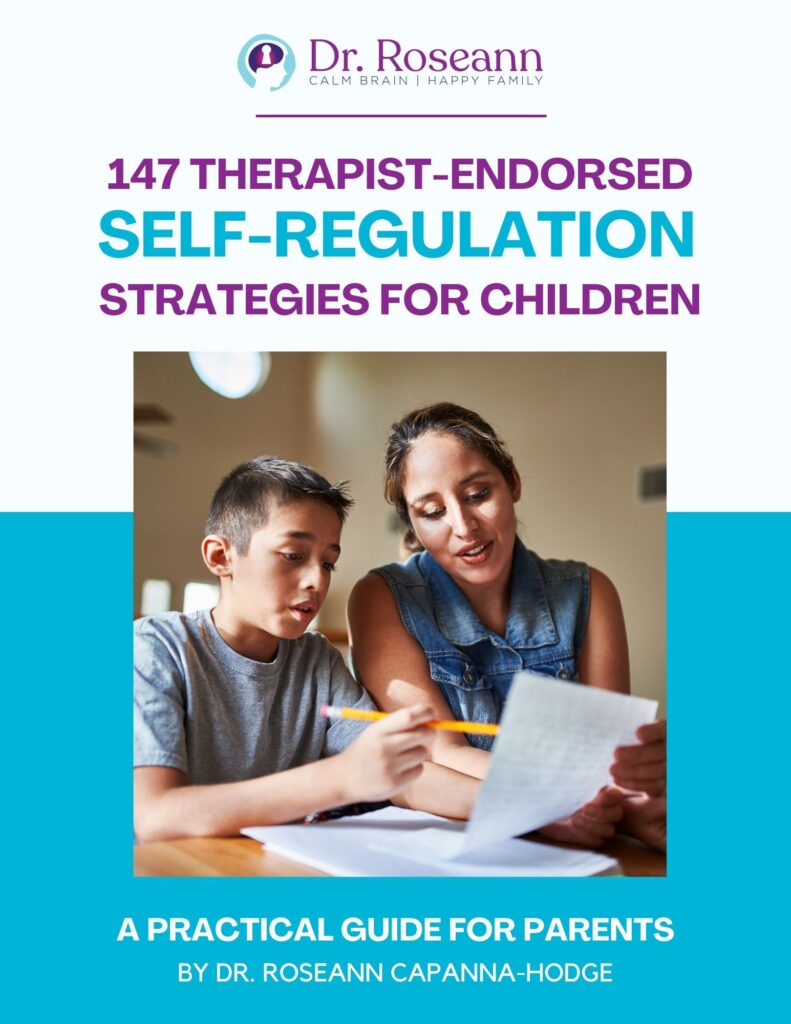Anxiety disorders can cast a shadow over a child's life. It affects their every move and stifles their potential. Furthermore, anxiety disorders impose a heavy burden not only on the child but on the entire family.
Traditional treatments, such as medication or therapy, may relieve psychiatric symptoms to some extent, but they often come with side effects or limitations. This is where neurofeedback steps in. Neurofeedback therapy works by targeting the brain wave patterns associated with anxiety and training the brain to function in a more balanced and regulated manner.
Even though anxiety medications like selective serotonin reuptake inhibitors can temporarily relieve anxiety and depression symptoms, they generally fail to tackle the underlying cause. They also have side effects most of the time. Moreover, they tend to reinforce avoidant behaviors instead of teaching individuals how to manage stress and uncomfortable feelings effectively.
Understanding Anxiety in Children
But before diving into neurofeedback treatment, it's essential first to understand childhood anxiety. Anxiety comes in many forms, such as generalized anxiety disorder and social anxiety disorder, and manifests in various ways. That is why it requires personalized support and guidance.
The prevalence of major depressive disorder and anxious subjects increased significantly in the younger generation. Research shows that even before the pandemic, there was a 27% increase in pure anxiety patients and a 24% increase in depression cases between 2016 and 2019 (Lebrun-Harris et al., 2022).
Symptoms of Anxiety in Children
Children who have experienced the following symptoms on most days for more than six months and find that these symptoms significantly impact their daily lives may be diagnosed with generalized anxiety disorder.
- Agitation and restlessness
- Excessive worrying
- Trouble concentrating
- Irritability
- Muscle tension
- Sleep disturbance
- Easily fatigued
Does Neurofeedback Work for Anxiety?
Neurofeedback therapy offers a promising avenue for managing anxiety in children as it provides a non-invasive and drug-free approach to mental wellness. This therapy can target the root cause of anxiety at its core – the brain.
Neurofeedback works on a deep, unconscious level, influencing most brain processes. Training the brain to produce relatively pure brain signals, such as alpha, theta, and beta waves, teaches children to regulate their emotions and experience lasting relief from anxiety.
Neurofeedback harnesses the brain's ability to learn and adapt. Providing real-time feedback on brain activity allows children to recognize and modify their brain wave patterns to reduce their anxiety symptoms.
My extensive experience in clinical psychology has shown that neurofeedback training can benefit a wide range of anxiety disorder patients, from those with severe anxiety to children struggling with chronic PTSD (post traumatic stress disorder) or panic disorder, which involves extreme fear. The beauty of neurofeedback for anxiety and depression lies in its ability to target the root cause of anxiety in the brain without relying on drug treatments.
I remember Emily, a 10-year-old girl who had been battling crippling anxiety for years. Traditional treatments offered little relief, and her parents were desperate for a solution when they came to me. That's when they discovered neurofeedback therapy and decided to give it a try.
After just a few sessions, Emily's parents noticed a remarkable difference in their child’s interaction and performance tasks. Her anxiety decreased linearly, her muscle tension eased, her blood pressure normalized, and, most importantly, her depression and anxiety symptoms began to subside. It was a turning point for the entire family.
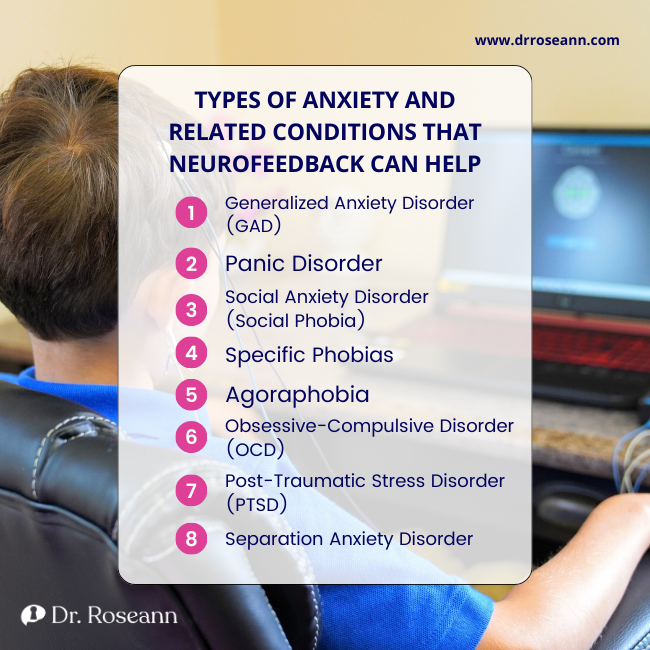
How Neurofeedback Works
Neurofeedback’s ability to target the brain's central nervous system directly differentiates it from other therapies or medications. It doesn’t just address the symptoms. Think of it as reprogramming a faulty circuit. It identifies and corrects brain wave patterns associated with anxiety, allowing us to rewire the brain, which leads to long-lasting relief.
Neurofeedback training involves a Quantitative EEG or QEEG brain map as its first step. It is a non-invasive and painless process that measures the brain's electrical activity through sensors placed on the head.
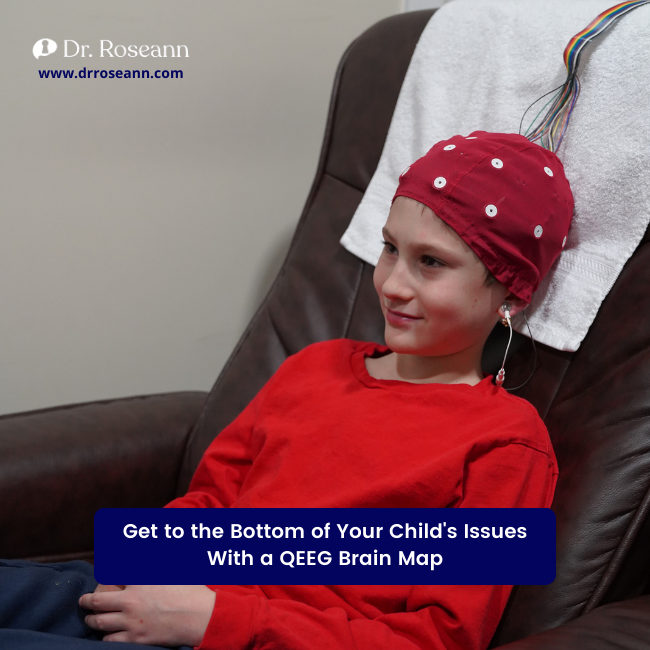
The EEG Biofeedback data from this is statistically analyzed to determine brainwave patterns and diagnostic information, allowing practitioners to design a personalized protocol to address specific issues. In addition, this computer analysis highlights any variations from the norm and shows brain areas with too much or too little EEG activity.
After designing a customized protocol to address anxiety disorders or other mental disorders, neurofeedback therapy begins. Using computer technology, patients are reinforced for changing their brainwave activity from a dysregulated pattern to a healthy one.
Visual and auditory stimuli, such as movies and dings, reinforce the brain whenever a pre-set goal is achieved. As a result, the therapy is enjoyable, and the brain quickly responds to the reinforcement. As a result, the brain begins to regulate, reducing symptoms over time.
The number of neurofeedback sessions varies from person to person, such as for healthy and anxious subjects. However, most individuals require two sessions per week. At the same time, some may notice a reduction of symptoms after the first session, but most experience a gradual decrease over time (Luctkar-Flude et al., 2017).
Neurofeedback training, combined with psychotherapy, helps manage stress response and address nervous system dysregulation, underlying feelings, negative thinking, and behaviors, resulting in lasting change. Research shows the effectiveness of neurofeedback therapy for anxiety and depression, and it has been proven to be minimally invasive with minimal side effects (Hammond et al., 2016).
For children and teens with anxiety, neurofeedback focuses on reducing anxious brain activities and improving brain function. It allows children to concentrate, manage their anxious thoughts, and alleviate physical symptoms such as stomach aches, headaches, and sleep disturbances.
Regulating the brain's structures and communication between different areas allows neurofeedback to mitigate the overstimulation that leads to anxiety disorders. The root cause of anxiety disorders is the hyperactivity of the brain caused by internalized anxious thoughts and bodily sensations. In other words, the brain gets stuck in a pattern of over-communication.
Natural Solutions for Kid's Anxiety
While neurofeedback is an effective tool to calm the brain and produce long-term changes, it is not a magic wand that can make anxiety and depressive disorders disappear. Therefore, other natural treatment solutions should be carried out to address anxiety, depression, and behavioral issues. Learning new behaviors that support healthy coping skills to manage frustration and stress is essential.
Aside from neurofeedback, the child also can benefit from PEMF, cognitive behavioral therapy, nutrition, magnesium, and other dietary supplements. These methods are vital in creating an effective treatment plan for your child.
Get guidance from qualified health professionals to know the ideal neurofeedback protocol and the estimated number of sessions required to promote positive mood and behavior in your child while improving their cognitive function. Most mental health conditions need two to three weekly sessions over five to six months.
Besides anxiety and depression, neurofeedback is also helpful for children with autism spectrum disorder, obsessive-compulsive disorder (OCD), and other psychiatric disorders. In addition, it can help address negative emotions, panic attacks, and poor executive function.
Ready to Get Started with Neurofeedback?
In our BrainBehaviorReset™, we work with children and their families. We begin with a strategy session and a QEEG or a brain check to see how the brain functions. Then, a carefully crafted custom care plan is incorporated with the best of science that works in changing the brain and behavior. Take the Solutions Matcher to get started.
How do you develop anxiety?
Anxiety can develop due to a combination of genetic, environmental, and psychological factors. Traumatic experiences, chronic stress, a family history of anxiety disorders, and imbalances in brain chemistry are among the contributors.
How do you treat anxiety disorders holistically in children?
Treating anxiety disorders in children often involves a combination of therapy, such as cognitive-behavioral therapy (CBT), and other natural treatments like neurofeedback. Techniques like mindfulness, relaxation exercises, and parent training can also be crucial in anxiety management and promoting overall well-being.
Where has holistic anxiety relief chiefly relied upon?
Holistic anxiety relief chiefly relies on a multifaceted approach that addresses the interconnected aspects of an individual's life, including physical, emotional, and spiritual well-being. Techniques such as mindfulness, relaxation exercises, dietary changes, exercise, and therapy play key roles in promoting overall balance and reducing anxiety symptoms.
What do alpha, theta, and beta waves do in the brain?
Alpha, theta, and beta waves are different types of brain waves that serve various functions in the brain. Alpha waves are associated with a state of relaxation and calmness, often occurring when a person is relaxed but awake. Theta waves are linked to deep relaxation, mindfulness meditation, and creativity, playing a role in memory formation and emotional processing. Beta waves, however, are associated with active concentration, problem-solving, and alertness, commonly observed during periods of focused mental activity.
What are gamma wave power values?
Gamma wave power values refer to the amplitude or strength of gamma brainwaves. Average gamma power is a high-frequency neural oscillation ranging from approximately 25 to 100 Hz. These gamma wave power changes are associated with various cognitive functions, including attention, memory, and perception.
What are the ideal alpha and theta amplitude values?
Ideal alpha amplitude values typically range from 20 to 50 microvolts, while theta amplitude values usually fall between 10 and 30. These ranges may vary slightly depending on age, individual differences, and recording conditions. However, deviations from the average theta power could indicate abnormalities in brain function and may be targeted in neurofeedback therapy to promote optimal mental well-being.
What are the desirable alpha wave power changes?
Desirable alpha wave power changes typically involve an increase in average alpha power, indicating a state of relaxation, calmness, and focused attention. These changes are often associated with reduced anxiety levels, improved mood, and enhanced cognitive function.
What are the expected theta wave power changes in neurofeedback?
In neurofeedback, the expected theta wave power changes depending on the individual's presenting symptoms and treatment goals. Generally, the aim is to achieve a balance in theta wave activity.
What is the complex system control theory?
Complex system control theory is a branch of systems theory that deals with understanding and manipulating complex systems. It focuses on how systems with many interconnected components, such as the brain or ecosystems, behave and respond to environmental changes.
How is power spectrum estimation obtained in neurofeedback?
In neurofeedback, power spectrum estimation is typically obtained through electroencephalography (EEG) technology. EEG electrodes are placed on the scalp to measure electrical activity in the brain, and the recorded signals are processed to estimate the power spectrum.
How does neurofeedback affect behavioral activation sensitivity?
Neurofeedback can influence behavioral activation sensitivity by modulating brainwave patterns associated with arousal and motivation. This process facilitates adaptive responses to environmental cues and promotes a more positive and fulfilling life experience.
How does neurofeedback affect a child’s psychological variables?
Neurofeedback can significantly impact a child's psychological variables by targeting and training specific brainwave patterns associated with emotional regulation, attention, and behavior.
How do you go about a subject's neurofeedback mindfulness adjustment?
Neurofeedback mindfulness regulation techniques educate the subject about its benefits, guide them through mindfulness exercises, and integrate these practices into neurofeedback sessions.
Citations
Hammond, D. C., Novian, D. A., & Duffy, F. H. (2016, November 11). Comprehensive Bibliography of Neurofeedback Research. ISNR. https://isnr.org/isnr-comprehensive-bibliography
Lebrun-Harris, L. A., Ghandour, R. M., Kogan, M. D., & Warren, M. D. (2022). Five-Year Trends in US Children’s Health and Well-being, 2016-2020. JAMA Pediatrics, 176(7). https://doi.org/10.1001/jamapediatrics.2022.0056
Luctkar-Flude, M., Groll, D., & Tyerman, J. (2017). Using neurofeedback to manage long-term symptoms in cancer survivors: Results of a survey of neurofeedback providers. European Journal of Integrative Medicine, 12, 172–176. https://doi.org/10.1016/j.eujim.2017.06.003
Dr. Roseann is a mental health expert in Neurofeedback who is frequently in the media:
- Helping Children Thrive Podcast Benefits of Neurofeedback for Children with ADHD
- It's Gonna Be OK! With Dr. Roseann Podcast: Neurofeedback Series
- Mel Robbins Show: Neurofeedback
Always remember… “Calm Brain, Happy Family™”
Disclaimer: This article is not intended to give health advice and it is recommended to consult with a physician before beginning any new wellness regime. *The effectiveness of diagnosis and treatment vary by patient and condition. Dr. Roseann Capanna-Hodge, LLC does not guarantee certain results.
Are you looking for SOLUTIONS for your struggling child or teen?
Dr. Roseann and her team are all about science-backed solutions, so you are in the right place!
Download this Game-Changing Roadmap:
Empower Your Child to Rise Above Anxiety and Flourish Without Relying on Medication
Dr. Roseann is a Children’s Mental Health Expert and Licensed Therapist who has been featured in/on hundreds of media outlets including The Mel Robbins Show, CBS, NBC, PIX11 NYC, Today, FORBES, CNN, The New York Times, The Washington Post, Business Insider, Women’s Day, Healthline, CNET, Parade Magazine and PARENTS. FORBES called her, “A thought leader in children’s mental health.”

She coined the terms, “Re-entry panic syndrome” and “eco-anxiety” and is a frequent contributor to media on mental health.
Dr. Roseann Capanna-Hodge has three decades of experience in working with children, teens and their families with attention-deficit hyperactivity disorder (ADHD), autism, concussion, dyslexia and learning disability, anxiety, Obsessive Compulsive Disorder (OCD), depression and mood disorder, Lyme Disease, and PANS/PANDAS using science-backed natural mental health solutions such as supplements, magnesium, nutrition, QEEG Brain maps, neurofeedback, PEMF, psychotherapy and other non-medication approaches.
She is the author of three bestselling books, It’s Gonna Be OK!: Proven Ways to Improve Your Child's Mental Health, The Teletherapy Toolkit, and Brain Under Attack. Dr. Roseann is known for offering a message of hope through science-endorsed methods that promote a calm brain.
Her trademarked BrainBehaviorResetⓇ Program and It’s Gonna be OK!Ⓡ Podcast has been a cornerstone for thousands of parents facing mental health, behavioral or neurodevelopmental challenges.
She is the founder and director of The Global Institute of Children’s Mental Health, Neurotastic™Brain Formulas and Dr. Roseann Capanna-Hodge, LLC. Dr. Roseann is a Board Certified Neurofeedback (BCN) Practitioner, a Board Member of the Northeast Region Biofeedback Society (NRBS), Certified Integrative Mental Health Professional (CIMHP) and an Amen Clinic Certified Brain Health Coach. She is also a member of The International Lyme Disease and Associated Disease Society (ILADS), The American Psychological Association (APA), Anxiety and Depression Association of America (ADAA) National Association of School Psychologists (NASP), International OCD Foundation (IOCDF).
© Roseann-Capanna-Hodge, LLC 2024
Disclaimer: This article is not intended to give health advice and it is recommended to consult with a physician before beginning any new wellness regime. *The effectiveness of diagnosis and treatment vary by patient and condition. Dr. Roseann Capanna-Hodge, LLC does not guarantee certain results.

